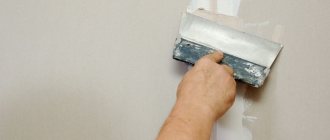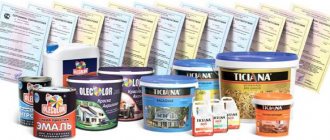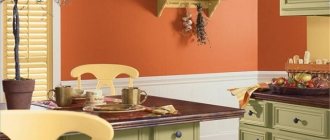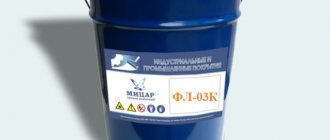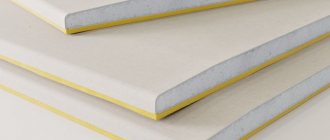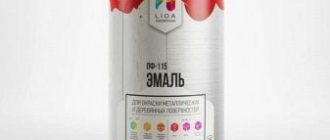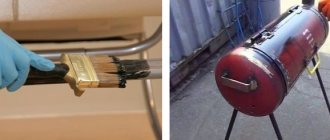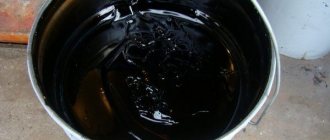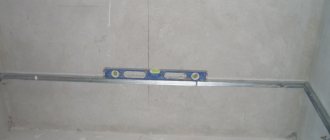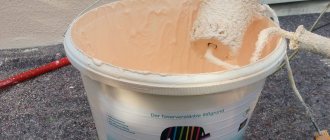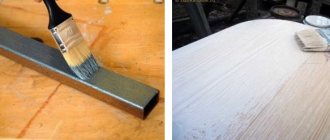Application area:
for external and internal works. Acrylic paint complies with the characteristics of GOST, subject to the instructions for preparing the base, application, and also when used in a temperate climate. Acrylic facade paints VDAK-111GOST 28196–89 are breathable paints, as they create a coating with micropores through which air and air vapor pass.
Acrylic facade paint VDAK-111GOST 28196–89 is applied to mineral surfaces: primed concrete, putty, plasterboard, fiberboard, chipboard, sanded and well-primed gypsum and cement plasters.
Retains protective properties within 2 points for about 5 years. It is resistant to weather conditions. Used for finishing facades. Suitable for use in interiors with high humidity (excluding saunas, baths, etc.).
- Durable coating.
- Water based.
- Fire- and explosion-proof.
- Vapor permeable.
- Fits well and is easy to work with.
- Doesn't splash much.
- White paint does not yellow over time.
- Good adhesion.
They differ from vinyl acetate compounds and silicon-organic products in a lower degree of electrification and greater environmental friendliness. Water-based, no solvents, no pungent odor.
— Minimum order of the product is from 100 kg. — We will arrange delivery. Cost and terms should be confirmed in advance.
TECHNICAL CONDITIONS
Official publication
Moscow
Standardinform
2007
INTERSTATE STANDARD
WATER-DISPERSION PAINTS
Specifications
Water-dispersion paints. Specifications
GOST
28196-89
MKS 87.040 OKP 23 1600
Date of introduction 07/01/90
This standard applies to water-dispersion paints, which are suspensions of pigments and fillers in aqueous dispersions of synthetic polymers with the addition of various auxiliary substances (emulsifier, stabilizer, etc.).
The paints are intended for interior and exterior painting of buildings and structures on brick, concrete, plastered, wooden and other porous surfaces (except for floors), on primed metal surfaces, on old coatings, for painting fruit trees, ornamental trees, shrubs in order to increase their winter hardiness, protection from sunburn, protection from rodents and covering wounds.
Coatings based on water-dispersion paints VD-AK-111, VD-AK-111r, VD-KCH-183 retain protective properties no higher than score 2 according to GOST 9.407 in temperate climates for at least 5 years.
The coating based on water-dispersion paint VD-KCH-577 lasts on a young tree for 1 year, on a fruit-bearing tree for 2 years.
(Changed edition, Amendment No. 1).
BRANDS AND TECHNICAL REQUIREMENTS
1.1. Depending on the composition and purpose of the paint, the following brands are available:
VD-VA-224 - based on homopolymer polyvinyl acetate dispersion for work inside
rooms, as well as rooms with high humidity (kitchens, bathrooms, toilets);
VD-KCh-26A, VD-KCh-26 - based on styrene-butadiene latex for indoor work (paint brand VD-KCh-26A - using titanium dioxide, paint brand VD-KCh-26 - lithopone);
VD-AK-111, VD-AK-111r - based on copolymer acrylate dispersion for external and internal painting of buildings and structures (VD-AK-111r is used to produce relief paint);
VD-KCh-183 - based on aqueous dispersions of synthetic polymers, for exterior painting of buildings and structures and interior finishing work (except for surfaces subject to intensive washing);
VD-KCh-577 - based on aqueous dispersions of synthetic polymers for painting fruit, ornamental trees and shrubs in order to increase their winter hardiness, protect against sunburn, protect against rodents and cover wounds.
1.2. Water-dispersion paints must be manufactured in accordance with the requirements of this standard according to recipes and technological regulations approved in the prescribed manner.
1.3. Characteristics
1.3.1. Paints must comply with the requirements and standards specified in Table 1.
Official publication ★
Reproduction is prohibited
© Standards Publishing House, 1989 © Standartinform, 2007
Table 1
| Standard for brands | ||||||||
| Name | VD-VA-224 | VD-KCH-26A | VD-KCH-26 | VD-AK-111 | VD-AK-111r | VD-KCH-183 | VD-KCH-577 | Method |
| indicator | tests | |||||||
| OKP 23 | OKP 23 | OKP 23 | OKP 23 | OKP 23 | OKP 23 | OKP 23 | ||
| 1611 1001 | 1621 0201 | 1621 0101 | 1631 0101 | 1632 0243 | 1621 0401 | 1621 0500 | ||
| 1. Film color | Must be within the permissible deviations established - | By i. 4.3 | ||||||
| paints: | samples (standards) | "Card Index" colors | or control | |||||
| color samples | ||||||||
| white | Must be within | — | Must be | |||||
| allowed deviations established | within tolerance - | |||||||
| control samples | possible deviations, | |||||||
| established | ||||||||
| control samples | ||||||||
| pale-fist- | ||||||||
| pulley | — | — | — | — | 345, 346 | |||
| 2. Appearance | After | drying paint | should form a film | with a flat | By i. 4.3 | |||
| films | uniform matte surface | |||||||
| 3. Mass up- | By | |||||||
| for non-volatile substances | GOST 17537 | |||||||
| substances, % | 53-59 | 52-57 | 56—61 | 52-57 | 47-52 | 52-57 | 55-60 | and and. 4.4 present standard |
| 4. Paint pH | 6,8-8,2 | No less | Not | 8,0-9,0 | 7,5-9,5 | No less | No less | By i. 4.5 |
| 9,0 | less | 8,0 | 6,5 | |||||
| 9,0 | ||||||||
| 5. Covering power | By | |||||||
| dried film | GOST 8784, | |||||||
| ki, g/m2, no more | 120 | 140 | 210 | 100 | 80 | 120 | 180 | section 1, 2 and i. 4.6 us- |
| sinking standard | ||||||||
| 6. Durability | By | |||||||
| films to static | GOST 9.403, | |||||||
| who is affected | method A and | |||||||
| water, at temperature | And. 4.7 us- | |||||||
| round (20±2) °С, h, not | sinking | |||||||
| less | 12 | — | — | 24 | 24 | 24 | — | standard |
| 7. Frost resistance - | According to clause 4.8 | |||||||
| bone paint, cycles, no less | 5 | 5 | 5 | 5 | 5 | 5 | 5 | |
| 8. Conditional light | By | |||||||
| resistance (due to | GOST 21903, | |||||||
| change in coefficient | method 2 and | |||||||
| diffusion | And. 4.9 us- | |||||||
| reflection), %, | sinking | |||||||
| no more | — | — | — | 5 | 5 | 5 | — | standard |
| 9. Degree of ne- | By | |||||||
| retira, microns, no more | 30 | 70 | 70 | 60 | 60 | 60 | 60 | GOST 6589 |
| 10. Drying time | By | |||||||
| Hania up to degree 3 at temperature (20±2) °С, h, no more | 1 | 1 | 1 | 1 | 1 | 1 | 1 | GOST 19007 |
(Changed edition, Amendment No. 1).
1.3.2. Additional characteristics of paints are given in Appendix 1.
(Introduced additionally, Amendment No. 1).
1.4. Packaging - according to GOST 9980.3.
1.5. Marking - in accordance with GOST 9980.4 with the application of a manipulation sign “Temperature Limitation” in accordance with GOST 14192.
(Changed edition, Amendment No. 1).
SAFETY REQUIREMENTS
2.1. Water-dispersion paints are fire and explosion proof.
2.2. During the production, testing and use of paints, fire safety and industrial sanitation requirements in accordance with GOST 12.3.005 must be observed.
2.3. All work with paint must be carried out in rooms equipped with supply and exhaust ventilation, ensuring the air condition of the working area in accordance with GOST 12.1.005.
2.4. The maximum permissible concentrations and hazard class of vapors of monomers and paint components are given in Table 2.
table 2
| Name component | Maximum permissible concentration, mg/m2 | Class dangers | ||
| in the air of the working area of the production premises | in the water of reservoirs | in the atmosphere | ||
| Polyvinyl acetate dispersion: | ||||
| on vinyl acetate | 10 | 0,2 | 0,15 | 3 |
| by acetaldehyde | 5 | 0,2 | 0,01 | 3 |
| on dibutyl phthalate | 0,5 | 0,2 | — | 2 |
| Latex butadiene nitrile: | ||||
| for acrylonitrile | 0,5 | 2,0 | 0,03 | 2 |
| Styrene-butadiene latex: | ||||
| for styrene | 30/10 | od | 0,003 | 3 |
| Emulsion MBM-5s: | ||||
| by methyl methacrylate | 10 | 0,01 | 0,1 | 3 |
| for butalacrylate | 10 | 0,01 | — | 3 |
| for methacrylic acid | 10 | 1,0 | — | 3 |
| Ethylene glycol | 5 | 1,0 | — | 3 |
| Tiuram: | ||||
| (tetramethylthiuram disulfide) | 0,5 | 1,0 | 0,006 | 2 |
| Aerosil | 1,0 | — | — | 3 |
| Pentachlorophenolate | od | 5,0 | 0,001 | 1 |
| White Spirit | 300 | — | — | 4 |
| Titanium dioxide | 10 | — | — | 4 |
2.5. The harmful substances that make up the paint have a toxic effect on the hematopoietic organs, nervous system, skin, mucous membranes of the eyes and respiratory tract. The dried coating has no harmful effects on the human body.
2.4, 2.5. (Changed edition, Amendment No. 1).
2.6. Persons associated with the manufacture, testing and use of paints must be provided with special clothing and personal protective equipment in accordance with GOST 12.4.011 and GOST 12.4.103.
2.7. Monitoring compliance with maximum permissible emissions (MPE) into the atmosphere, approved in accordance with the established procedure, must be carried out in accordance with GOST 17.2.3.02.
ACCEPTANCE RULES
3.1. Acceptance rules - according to GOST 9980.1.
3.2. The manufacturer determines the standards for indicators 5, 6, 8 of Table 1 periodically once a month for at least three batches.
The manufacturer determines the standards for indicators 7, 9, 10 of Table 1 periodically at the request of the consumer.
If the periodic test results are unsatisfactory, the manufacturer shall check each batch until satisfactory test results are obtained in a row of at least six batches.
3.1. 3.2. (Changed edition, Amendment No. 1).
TEST METHODS
4.1. Sampling - according to GOST 9980.2.
4.2. Preparing samples for testing
Before testing, the paint is stirred and the mass fraction of non-volatile substances, pH, degree of grinding, and frost resistance are determined.
To determine other indicators, the paint is, if necessary, diluted with drinking water in accordance with GOST 2874* with a hardness (1/2 CaCl2) of no more than 7.0 mol/m3, condensate or distilled water in accordance with GOST 6709 to a viscosity of 20-30 s using a VZ-246 viscometer with a nozzle diameter of 4 mm (or VZ-4) at a temperature of (20.0+0.5) °C when applied by pneumatic spraying or up to a viscosity of 40-80 s when applied with a brush. Then filter through mesh No. 1 according to GOST 6613 or two layers of gauze and apply to plates prepared according to GOST 8832, section 3.
The color and appearance of the film, the resistance of the paint film to the static effects of water are determined on wooden plates measuring 50×100 mm, 5-6 mm thick, conditional light fastness - on drawing paper in accordance with GOST 597 size 100×200 mm, hiding power and drying time - on special-purpose glass plates measuring 90×120 mm, thickness 1.2 mm according to TU 21-0284461-058.
When determining the drying time, the paint is applied in one layer; when determining the color and appearance of the paint film, conditional light fastness, the paint is applied in two layers. When determining resistance to static water, paint is applied in two layers on both sides of the plate, as well as on the sides. Drying time between layers is 1 hour at a temperature of (20+2) °C.
When determining hiding power, the second and subsequent layers are dried for 1 hour at a temperature of (20+2) °C, then 1.5 hours at a temperature of (60+2) °C and cooled for 0.5 hours at a temperature of (20+2) °C.
The thickness of a single-layer film is 30-40 microns, a two-layer film is 60-80 microns. The thickness is measured with a micrometer type MK 25-1 according to GOST 6507 or another type of device with an error of no more than +3 µm.
Before testing according to indicators 6, 8 of Table 1, the film is kept for 48 hours at a temperature of (20+2) °C and a relative humidity of 60-70%, according to indicator 1 - for 2 hours at a temperature of (20+2) °C .
(Changed edition, Amendment No. 1).
4.3. Determining the color and appearance of the paint film
The color of the dried paint film is determined by visual comparison with the color of the corresponding samples (standards) of the “Card Index” color or control color samples in natural or artificial daylight diffused light. The samples to be compared should be in the same plane at a distance of 300-500 mm from the observer’s eyes at a viewing angle that excludes surface gloss.
The appearance of the dried paint film is determined visually in natural or artificial daylight.
In case of disagreement in the assessment of color and appearance, the determination in natural daylight is taken as the final result.
* GOST R 51232-98 is in force on the territory of the Russian Federation.
4.4. The mass fraction of non-volatile substances is determined according to GOST 17537, a sample of paint is dried at a temperature of (105 + 2) ° C for 40 minutes.
4.5. Determination of paint pH
4.5.1. Instruments, reagents and materials
pH meter with glass electrode, measurement error no more than 0.1 pH.
Glass glass V-2—50 according to GOST 25336.
Hydrochloric acid according to GOST 3118, solution with a mass fraction of hydrochloric acid of 3%.
Distilled water according to GOST 6709.
4.5.2. Carrying out the test
The paint is poured into a 50 cm3 glass, thoroughly washed with distilled water, and the pH is determined. A new glass must be pre-treated with a hot solution of hydrochloric acid, and then rinsed thoroughly with distilled water.
4.5.3. Processing the results
The result of measuring paint pH is taken to be the arithmetic mean of the results of two parallel determinations, the absolute discrepancy between which should not exceed the permissible discrepancy of 0.1 pH.
The measurement result is rounded to the first decimal place.
The permissible total error of pH determination results is +0.1 with a confidence level of P = 0.95.
4.6. Determination of the hiding power of the dried film - according to GOST 8784, section. 1 or sec. 2. In case of disagreement in the assessment, the determination of hiding power by the instrumental method is taken as the final result.
4.6.1. Instrumental method for contrast ratio - according to GOST 8784, section. 2 with the following additions.
4.6.1.1. Carrying out the test
On a glass plate prepared according to GOST 8832, section. 3, measured (length, width) and weighed, apply one or two layers of paint.
The plate with the applied paint is alternately placed on a black or white plate and the brightness coefficients are measured at a wavelength of 560 nm (or a green filter at a wavelength of 560 nm) at four points on the film. The brightness coefficient is determined in accordance with the instructions for the optical device used for this determination.
The plate with the paint film is weighed and the contrast ratio (Q:
where 7?j, R2 are the brightness coefficients when applying a plate with a film of paint to the black and white plates, respectively.
The result of measuring the contrast ratio is taken to be the arithmetic mean of the results of four parallel determinations, the discrepancy between which should not exceed the permissible discrepancy of 0.02.
The final result is rounded to the second decimal place.
If the contrast ratio is less than 0.98, apply another layer of paint and repeat the determination of the contrast ratio.
If the contrast ratio is more than 0.99, the determination is repeated, applying a smaller amount of paint to the plate.
With a contrast ratio of 0.98 to 0.99, the hiding power value is calculated.
4.6.1.2. Processing the results
Coverage index (D), g/m2, is calculated using the formula
106 • ( t . - t ,|)
D = ——!-2-
5
where m1 is the mass of the plate with the dried paint film, g; m0—mass of unpainted plate, g;
106 is the coefficient for converting the area dimension from mm2 to m2;
S—plate area, mm2.
For glass plates measuring 90x120 mm, the ratio is 92.6.
The arithmetic mean of the results of two
parallel determinations, the discrepancy between which should not exceed the permissible discrepancy of 6 g/m2. The final result is rounded to the nearest whole number.
The permissible total error of the measurement result is +4 g/m2 with a confidence level of P = 0.95.
4.6—4.6.1.2. (Changed edition, Amendment No. 1).
4.7. The resistance of the film to the static effects of water is determined according to GOST 9.403, method A.
After testing, the samples are kept before inspection at a temperature of (20+2) °C in
for 3 hours
Lightening of the paint film is allowed.
4.8. Determination of frost resistance of paint
4.8.1, 4.8.1.1—4.8.1.3. (Excluded, Amendment No. 1).
4.8.2. Method 2
4.8.2.1. Measuring instruments, auxiliary devices, reagents and materials
Refrigerating chamber providing a temperature of minus (40+2) °C.
Thermometer in accordance with GOST 28498 with measurement limits from minus 90 to 30 °C and a division value of 1 °C.
Metal can according to GOST 6128 or polyethylene.
Glass plate.
Glass rod.
4.8.2.2. Carrying out the test
A metal can is filled halfway with paint, closed with a lid and placed in a refrigerator, where it is kept for 6 hours at a temperature of minus (40+2) °C, after which the can is left for 18 hours at room temperature. The cycle is repeated five times.
Then the paint is mixed and its resistance to coagulation is visually determined by evenly distributing the paint with a glass rod over a glass plate (test glass). Paint that has not been tested for frost resistance is also applied to a glass plate (control glass). The control and test glass are compared with each other.
Paint is considered frost-resistant if, after five freeze-thaw cycles, no hard lumps appear in a thin layer of paint.
(Changed edition, Amendment No. 1).
4.9. Conditional light fastness is determined according to GOST 21903, method 2.
From the middle part of three paints, prepared as indicated in and. 4.2 of this standard, cut out one sample measuring 50x50 mm. The paint sample is placed for 24 hours under the lamp at a distance of (250+5) mm from it. After exposure under the lamp, the paint is kept for 2 hours in a dark place at a temperature of (20+2) °C before taking measurements.
4.10. When carrying out measurements and tests, it is allowed to use other measuring instruments and laboratory glassware with similar metrological characteristics.
TRANSPORTATION AND STORAGE
5.1. Transportation and storage - in accordance with GOST 9980.5.
5.2. Paints are transported at temperatures above 0 °C. Transportation is allowed at temperatures down to minus 40 °C, but for no more than 1 month.
Paints are stored in tightly closed containers in warehouses at temperatures above 5 °C.
(Changed edition, Amendment No. 1).
DIRECTIONS FOR USE
6.1. Before use, if necessary, defrost the paint at a temperature of (20+5) °C, mix thoroughly and dilute with water in accordance with the instructions. 4.2 of this standard. The paint is applied to prepared according to GOST 8832, section. 3, surfaces by brush, roller or air spray.
6.2. Paints of the brands VD-VA-224, VD-KCh-26A, VD-KCh-26, VD-AK-111, VD-KCh-183 are applied to the surface in two layers, paints of the brands VD-AK-111r and VD-KCh- 577 - in one layer.
Paint consumption per layer, g/m2:
VD-VA-224, VD-KCH-26A, VD-AK-111, VD-KCH-183 - 110-150;
VD-AK-Shr - 250-300;
VD-KCH-26 - 150-200.
The average consumption of VD-KCh-577 paint for a young tree is 30-40 g, for a fruit-bearing tree - 150 g.
6.1. 6.2. (Changed edition, Amendment No. 1).
6.3. The old indoor coating must first be washed with water and soap or washing powder, an ammonia solution or a 3% soda solution (1 tablespoon per 1 liter of water), and then with clean water.
Surfaces previously coated with chalk or lime paints must be thoroughly cleaned until completely removed.
Any loose outer covering must be completely removed.
Tinting of white paints with water-based pigment pastes is allowed.
6.4. VD-KCh-577 paint is applied in the autumn (before the leaves fall) and early spring periods at ambient temperatures above 0 °C. Wounds on trees are covered with undiluted paint in the spring and summer.
6.5. To obtain relief paint, a coarse filler is introduced into the VD-AK-111r paint before use - sand in accordance with GOST 8736 in a ratio of 2:1 by weight. Mix the paint thoroughly.
6.6. Water-dispersion paints for exterior use should be used at an ambient temperature of at least 8 °C.
If the temperature is below 15 °C, it is allowed to increase the drying time of each layer of paint to 24 hours.
6.7. The method of using water-dispersion paints intended for retail trade is given in Appendices 2, 3.
MANUFACTURER'S WARRANTY
7.1. The manufacturer guarantees that the paints comply with the requirements of this standard subject to the conditions of transportation and storage.
7.2. The guaranteed shelf life of paints is 12 months from the date of manufacture.
APPENDIX 1 Reference
additional characteristics
Reflection coefficient at an angle geometry of 0-45° of film for paints VD-VA-224, VD-AK-111, VD-KCh-183, VD-KCh-26A, VD-KCh-26 - no less than 82%, VD-KCh -577 – at least 75%.
The elasticity of the film when bending is 1 mm.
The mass fraction of residual styrene for VD-KCh-26A and VD-KCh-26 paints is no more than 0.03%.
Paint film washability, no more than:
VD-VA-224, VD-KCh-577 - 3.0 g/m2;
VD-KCh-26A, VD-KCh-26, VD-KCh-183 - 3.5 g/m2;
VD-AK-111, VD-AK-111r - 2.0 g/m2.
Conditional viscosity of paint according to a VZ-246 viscometer with a nozzle diameter of 4 mm at a temperature of (20.0±0.5) °C is not less than 30 s.
(Changed edition, Amendment No. 1).
APPENDIX 2 Mandatory
Label text
WATER-DISPERSIVE PAINT
(brand)
Purpose
Paint………….(brand) is intended for…………..(from the introductory part and clause 1.1 of this
standard).
Mode of application
The surface preparation method is in accordance with Section. 6 of this standard depending on the purpose of the paint.
Before use, the paint is thoroughly mixed and, if necessary, diluted with water and filtered through two layers of gauze.
The paint is applied to the prepared surface with a brush, roller, or spray gun in two layers with intermediate drying for 1 hour at a temperature of 18-22 ° C.
Paint consumption for a single-layer coating is ………… (Section 6 of this standard).
Paint tinting with aqueous pigment pastes is allowed.
Wash tools, containers, stains with warm water and soap until the paint dries.
Store the paint in a tightly closed container at temperatures above 0 °C. It is allowed to store paint at temperatures down to minus 40 °C for no more than 1 month. If frozen, the paint should be thawed at room temperature and mixed until smooth.
Guaranteed shelf life - 12 months.
Precautionary measures
The paint is fire and explosion proof.
Do not mix with other paints or thinners. (Changed edition, Amendment No. 1).
APPENDIX 3 Mandatory
Label text
WATER-DISPERSIVE PAINT VD-KCH-577 (white)
Purpose
Paint VD-KCH-577 is intended to increase the winter hardiness of fruit, ornamental trees, shrubs and to protect them from sunburn, to protect against rodents and to cover wounds.
On a young tree, the coating lasts for 1 year, on a fruit-bearing tree - 2 years.
Mode of application
The paint is applied in the autumn (before the leaves fall) and early spring periods at ambient temperatures above 0 °C.
Before use, the paint is thoroughly mixed and, if necessary, diluted with water. The paint is applied with a brush or sprayer in one layer. The average paint consumption for a young tree is 30-40 g, for a fruit-bearing tree - 150 g.
Wounds are covered with undiluted paint in the spring and summer.
Wash tools, containers, stains with warm water and soap until the paint dries.
Store the paint in a tightly closed container at temperatures above 0 °C. The paint can be stored at temperatures down to minus 40 °C for no more than 1 month. If frozen, the paint should be thawed at room temperature and mixed until smooth.
Guaranteed shelf life - 12 months.
Precautionary measures
The paint is fire and explosion proof.
Do not mix with other paints or thinners.
INFORMATION DATA
DEVELOPED AND INTRODUCED by the USSR Ministry of Chemical Industry
APPROVED AND ENTERED INTO EFFECT by Resolution of the USSR State Committee on Standards dated August 3, 1989 No. 2518
INSTEAD GOST 19214-80, GOST 20833-75, TU 6-10-1260-87, TU 6-10-2031-85, TU 6-10-2054-86, TU 6-10-2081-86
REFERENCE REGULATIVE AND TECHNICAL DOCUMENTS
| Designation of the referenced technical document | Number of paragraph, subparagraph |
| GOST 9.403-80 | 1.3.1, 4.7 |
| GOST 9.407-84 | Introductory part |
| GOST 12.1.005-88 | 2.3 |
| GOST 12.3.005-75 | 2.2 |
| GOST 12.4.011-89 | 2.6 |
| GOST 12.4.103-83 | 2.6 |
| GOST 17.2.3.02-78 | 2.7 |
| GOST 597-73 | 4.2 |
| GOST 2874-82 | 4.2 |
| GOST 3118-77 | 4.5.1 |
| GOST 6128-81 | 4.8.2.1 |
| GOST 6507-90 | 4.2 |
| GOST 6589-74 | 1.3.1 |
| GOST 6613-86 | 4.2 |
| GOST 6709-72 | 4.2, 4.5.1 |
| GOST 8736-93 | 6.5 |
| GOST 8784-75 | 1.3.1, 4.6, 4.6.1 |
| GOST 8832-76 | 4.2, 4.6.1.1, 6.1 |
| GOST 9980.1-86 | 3.1 |
| GOST 9980.2-86 | 4.1 |
| GOST 9980.3-86 | 1.4 |
| GOST 9980.4-2002 | 1.5 |
| GOST 9980.5-86 | 5.1 |
| GOST 14192-96 | 1.5 |
| GOST 17537-72 | 1.3.1, 4.4 |
| GOST 19007-73 | 1.3.1 |
| GOST 21903-76 | 1.3.1, 4.9 |
| GOST 25336-82 | 4.5.1 |
| GOST 28498-90 | 4.8.2.1 |
| TU 21-0284461-058-90 | 4.2 |
5. The validity period was removed by Gosstandart Decree No. 541 dated June 10, 1992
SAFETY REQUIREMENTS
2.1. Water-dispersion paints are fire and explosion proof.
2.2. During the production, testing and use of paints, fire safety and industrial sanitation requirements in accordance with GOST 12.3.005 must be observed.
2.3. All work with paint must be carried out in rooms equipped with supply and exhaust ventilation, ensuring the air condition of the working area in accordance with GOST 12.1.005.
2.4. The maximum permissible concentrations and hazard class of vapors of monomers and paint components are given in table. .
table 2
| Component name | Maximum permissible concentration, mg/m2 | Hazard Class | ||
| in the air of the working area of the production premises | in the water of reservoirs | in the atmosphere | ||
| Polyvinyl acetate dispersion: | ||||
| on vinyl acetate | 10 | 0,2 | 0,15 | 3 |
| by acetaldehyde | 5 | 0,2 | 0,01 | 3 |
| on dibutyl phthalate | 0,5 | 0,2 | — | 2 |
| Latex butadiene nitrile: | ||||
| for acrylonitrile | 0,5 | 2,0 | 0,03 | 2 |
| Styrene-butadiene latex: | ||||
| for styrene | 30/10 | 0,1 | 0,003 | 3 |
| Emulsion MBM-5s: | ||||
| by methyl methacrylate | 10 | 0,01 | 0,1 | 3 |
| for butalacrylate | 10 | 0,01 | — | 3 |
| for methacrylic acid | 10 | 1,0 | — | 3 |
| Ethylene glycol | 5 | 1,0 | — | 3 |
| Thiuram: (tetramethylthiuram disulfide) | 0,5 | 1,0 | 0,006 | 2 |
| Aerosil | 1,0 | — | — | 3 |
| Pentachlorophenolate | 0,1 | 5,0 | 0,001 | 1 |
| White Spirit | 300 | — | — | 4 |
| Titanium dioxide | 10 | — | — | 4 |
2.5. The harmful substances that make up the paint have a toxic effect on the hematopoietic organs, nervous system, skin, mucous membranes of the eyes and respiratory tract. The dried coating has no harmful effects on the human body.
2.4, 2.5. (Changed edition, Amendment No. 1).
2.6. Persons associated with the manufacture, testing and use of paints must be provided with special clothing and personal protective equipment in accordance with GOST 12.4.011 and GOST 12.4.103.
2.7. Monitoring compliance with maximum permissible emissions (MPE) into the atmosphere, approved in accordance with the established procedure, must be carried out in accordance with GOST 17.2.3.02.
DIRECTIONS FOR USE
6.1. Before use, if necessary, defrost the paint at a temperature of (20 ± 5) °C. mix thoroughly and dilute with water in accordance with clause 4.2 of this standard. The paint is applied to prepared according to GOST 8832, section. 3, surfaces by brush, roller or air spray.
6.2. Paints of the brands VD-VA-224, VD-KCh-26A, VD-KCh-26, VD-AK-111, VD-KCh-183 are applied to the surface in two layers, paints of the brands VD-AK-111r and VD-KCh- 577 - in one layer.
Paint consumption per layer, g/m2:
VD-VA-224, VD-KCH-26A, VD-AK-111, VD-KM-183 - 110 - 150;
VD-AK-111r - 250 - 300;
VD-KCH-26 - 150 - 200.
The average consumption of VD-KCh-577 paint for a young tree is 30 - 40 g, for a fruit-bearing tree - 150 g.
6.1, 6.2. (Changed edition, Amendment No. 1).
6.3. The old indoor coating must first be washed with water and soap or washing powder, an ammonia solution or a 3% soda solution (1 tablespoon per 1 liter of water), and then with clean water.
Surfaces previously coated with chalk or lime paints must be thoroughly cleaned until completely removed.
Any loose outer covering must be completely removed.
Tinting of white paints with water-based pigment pastes is allowed.
6.4. VD-KCH-577 paint is applied in the autumn (before the leaves fall) and early spring periods at ambient temperatures above 0 °C. Wounds on trees are covered with undiluted paint in the spring and summer.
6.5. To obtain relief paint, a coarse filler is introduced into the VD-AK-111r paint before use - sand in accordance with GOST 8736 in a ratio of 2:1 by weight. Mix the paint thoroughly.
6.6. Water-dispersion paints for exterior use should be used at an ambient temperature of at least 8 °C.
If the temperature is below 15 °C, it is allowed to increase the drying time of each layer of paint to 24 hours.
6.7. The method of using water-dispersion paints intended for retail trade is given in appendices.
ACCEPTANCE RULES
3.1. Acceptance rules - according to GOST 9980.1.
3.2. Standards for indicators , , table. the manufacturer determines periodically once a month for at least three batches.
Standards for indicators , , table. the manufacturer determines periodically at the request of the consumer.
If the periodic test results are unsatisfactory, the manufacturer shall check each batch until satisfactory test results are obtained in a row of at least six batches.
3.1, 3.2. (Changed edition, Amendment No. 1).
ANNEX 1
Information
additional characteristics
Reflection coefficient at an angle geometry of 0 - 45° of film for paints VD-VA-224, VD-AK-111, VD-KCh-183, VD-KCh-26A, VD-KCh-26 - no less than 82%, VD-KCh -577 – at least 75%.
The elasticity of the film when bending is 1 mm.
The mass fraction of residual styrene for VD-KCh-26A and VD-KCh-26 paints is no more than 0.03%.
Paint film washability, no more than:
VD-VA-224, VD-KCh-577 - 3.0 g/m2;
VD-KCh-26A, VD-KCh-26, VD-KCh-183 - 3.5 g/m2;
VD-AK-111, VD-AK-111r - 2.0 g/m2.
Conditional viscosity of paint according to a VZ-246 viscometer with a nozzle diameter of 4 mm at a temperature of (20.0 ± 0.5) °C is at least 30 s.
(Changed edition, Amendment No. 1).
WATER-DISPERSIVE PAINT
__________________________________
(brand)
Purpose
Paint ………………… (brand) is intended for ………….. (from the introductory part and clause 1.1 of this standard).
Mode of application
The surface preparation method is in accordance with Section. of this standard and depending on the purpose of the paint.
Before use, the paint is thoroughly mixed and, if necessary, diluted with water and filtered through two layers of gauze.
The paint is applied to the prepared surface with a brush, roller, or spray gun in two layers with intermediate drying for 1 hour at a temperature of 18 - 22 ° C.
Paint consumption for a single-layer coating is …………….. (section of this standard).
Paint tinting with aqueous pigment pastes is allowed.
Wash tools, containers, stains with warm water and soap until the paint dries.
Store the paint in a tightly closed container at temperatures above 0 °C. It is allowed to store paint at temperatures down to minus 40 °C for no more than 1 month. If frozen, the paint should be thawed at room temperature and mixed until smooth.
Guaranteed shelf life - 12 months.
Precautionary measures
The paint is fire and explosion proof.
Do not mix with other paints or thinners.
(Changed edition, Amendment No. 1).
